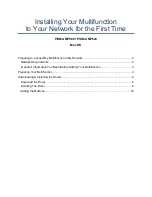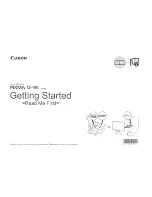
Chapter 9. Printer adjustments
Paper-Load-Position to Tear-Position relationship
115
Front Automatic Forms Thickness Adjustment
(AFTA)
.
.
.
.
.
.
.
.
.
.
.
.
.
.
. 116
Front Tear Position
.
.
.
.
.
.
.
.
.
.
. 116
Front Left Margin Alignment .
.
.
.
.
.
.
. 117
Front Paper Load Position .
.
.
.
.
.
.
.
. 117
Rear Automatic Forms Thickness Adjustment
(AFTA)
.
.
.
.
.
.
.
.
.
.
.
.
.
.
. 118
Rear Tear Position .
.
.
.
.
.
.
.
.
.
.
. 118
Rear Left Margin Alignment
.
.
.
.
.
.
.
. 119
Rear Paper Load Position .
.
.
.
.
.
.
.
. 120
Bidirectional Adjustment
.
.
.
.
.
.
.
.
. 120
Sensor Tune .
.
.
.
.
.
.
.
.
.
.
.
.
. 121
Quit From Menu .
.
.
.
.
.
.
.
.
.
.
. 121
This chapter describes the procedures for checking and changing the Printer
Adjustment parameters. The Printer Adjustments appear in both the Configuration
Menu and in the Operator Print Tests Menu. In the Configuration Menu, the
values can be set but not tested. In the Operator Print Tests, the adjustments can be
set and then tried by running a print test. (See Chapter 17, “Using the Operator
Print Tests.”) Printer adjustment parameters can be set for each paper source: Front
and Rear.
This chapter is divided into sections according to parameter. Refer to the partial
table of contents above for parameter and page listings.
Paper-Load-Position to Tear-Position relationship
There are Paper Load Position parameters for each forms path. These Paper Load
Position settings are used to vertically align printing on the forms. An example is
to center printing in a box on a preprinted form.
Whenever one of these Paper Load Position parameters is set, the printer
automatically adjusts the corresponding Tear Position value to compensate for the
change you made to the Load Position. This automatic adjustment keeps the forms
perforation aligned to the tear bar edge when the form is ejected. However, if
further adjustment is needed in the alignment of the forms perforation to the tear
bar, you should adjust the Tear Position value.
The automatic adjustment changes the tear adjustment by the same number of
units but in the opposite direction. Normally this adjustment means that Tear
Position is set to the offsetting (“equal but opposite”) value. Stated another way, if
the Load Position is set to +40, then the Tear Position is set to -40 (see example 1 in
the examples that follow). However, if the current setting of the Tear Position has
been changed by the operator to be different from the offsetting value, that
difference from the offsetting value is maintained by the printer (see example 2 in
the examples that follow).
Examples of how this works:
1.
The current values in the printer are Front Paper Load Position = 0 and Front
Tear Position = 0. The user sets Front Paper Load Position to +40. The printer
automatically sets Front Tear Position to -40.
2.
The current values in the printer are Front Paper Load Position = +40 and
Front Tear Position = -44. The user changes Front Paper Load Position to +50.
The printer automatically sets Front Tear Position to -54, maintaining the
difference of 4 from the normal offsetting value of “equal but opposite”.
115
Содержание 4247 X03
Страница 1: ...Compuprint 4247 Serial Matrix Printers Compuprint 4247 Model X03 Printer User s Guide MAN10296 00 00...
Страница 6: ...vi User s Guide...
Страница 8: ...viii User s Guide...
Страница 10: ...x User s Guide...
Страница 14: ...xiv User s Guide...
Страница 18: ...Printer parts Figure 1 Printer Parts Front and Rear View 2 User s Guide...
Страница 72: ...56 User s Guide...
Страница 116: ...100 User s Guide...
Страница 130: ...114 User s Guide...
Страница 140: ...124 User s Guide...
Страница 142: ...126 User s Guide...
Страница 146: ...130 User s Guide...
Страница 148: ...132 User s Guide...
Страница 150: ...134 User s Guide...
Страница 160: ...144 User s Guide...
Страница 188: ...172 User s Guide...
Страница 192: ...176 User s Guide...
Страница 199: ......
Страница 200: ...MAN10296 00 00 Printed in Italy MAN10296 00 00...
















































